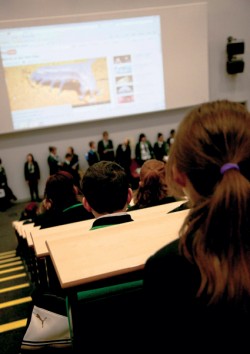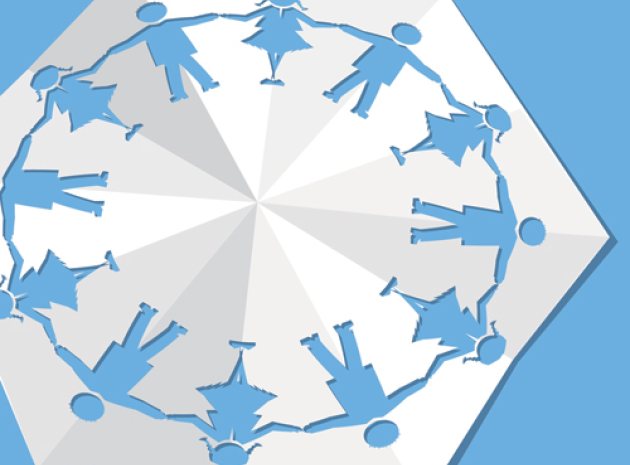The concept of 'human-centred' education, as explored by my colleague Garrett Thomson and me in our book, Rethinking Education: A Human-Centred Approach, originated from our work for the Guerrand-Hermès Foundation for Peace. The Foundation supports educational projects around the world, many of which embody alternative educational practices, and has organised various international conferences to explore innovative education.
After reflection on these experiences, two important points struck us with great force. The first was how alternative schools (referring to a wide range of educational institutions that include progressive, free and democratic schools, as well as those following an alternative ethos and pedagogy, such as Steiner and Montessori, and so forth) usually stand outside the state structure, a world apart in terms of thinking, culture and everyday practice. Through this dawning realisation, we started to frame a question that seemed especially relevant in the context of a country with a highly developed state education system like Britain: 'How can the two ways of thinking and acting better relate to each other?' We became convinced that, in order to improve, public education needs to take a sideways step. To continue on the current trajectory is to risk turning it into a huge social machine tuned for better national economic performance, with pre-set targets and pre-packaged educational goals. At the same time, alternative schools seem to be locked into relative isolation, appealing to relatively wealthy parents who want their children to escape the modernised and depersonalised worldview that seems to be embodied in most state education.

Stepping back from this duality, however, we felt both approaches – state and alternative education – had merits and demerits, and this set us the challenge of articulating the strategically key strengths and weaknesses of both. Theoretically, how can they be reconciled and combined? Practically, how can they contribute to each other, and work symbiotically? After some searching, we reformulated our main question as: 'How can the best aspects of alternative education benefit the state education system?' The best practices of alternative education are usually rooted in the idea that the individual child should be at the centre of education, treating a child's development in a holistic and individualised manner that allows each person to become more fully him or herself. The ideas behind such practices may not be entirely clear, yet they have inspired schools in countries such as Thailand, Colombia and Indonesia, within whose culture children are happy and able to transcend their extremely difficult socio-economic situations. In countries such as the UK, why should these benefits only be available to wealthier children?
Developing culture
The second point that hit us concerned secondary compared to primary education. In the latter, there is already some dialogue comparing the ideas and practises of alternative and state conceptions of education. This interchange extends back to the formation of nurseries and kindergartens, where the culture of schools is often influenced, perhaps indirectly, by the thought and practise of Montessori, Steiner and Pestalozzi. As a result, state primary schools are often very considerate of the children for whom they care.
However, this contrasts sharply with aspects of the culture of many secondary schools, which are often regarded as focusing primarily on grades and public examinations. They are places where childhood ends rather dramatically; young people are confronted head-on with the hard realities of (and preparation for) adult life. According to this idea of the system, young people need to knuckle down in order to be better prepared for the rigours of the workforce and market place, and for the so-called 'harsh world'. It is therefore not so easy for secondary educational institutions to embrace an alternative ethos in day-to-day teaching and learning.
For these reasons, we realised that it would be more fruitful and challenging to direct our earlier question specifically towards secondary schooling.

Parents want the best education for their children; the public is worried that educational standards are falling. Such concerns are clearly value-laden and mean little without some clarification of what is meant by these evaluations. For instance, there is little point in talking about how effective a course is without specifying what the relevant end results are and should be. Words such as 'effective', 'better', falling' and 'failing' presume ends, and these involve value judgements.
Furthermore, it is not sufficient to merely postulate some ends, and simply state that these are our goals. The fact that teachers have certain purposes in mind for their students, and the fact that the Government has a programme of outcomes established by law, does not mean that educational theory should simply accept those ends as given. There must be some reason why objectives are better or more appropriate than others, at least in a given context. We would argue that what constitutes 'better and more appropriate' objectives must take into consideration the development and flourishing of human beings.
Educational standards can and should be more human-centred. Human-centred education treats all those involved in education equally as humans and helps individuals develop to the fullest as happy human beings. We use the term 'human' because it has richer and wider connotations than 'person'. As well as indicating autonomy, free thought and self-consciousness, which are usually associated with the Enlightenment idea of being a person, it also includes other qualities, such as being noble, humane, sensitive and inquisitive. It also carries the idea of an embodied being, who cannot sit for hours behind a desk passively, and who needs to move, talk and laugh. The term is supposed to capture what are the best qualities of human beings in their fullness.
Human-centred education places the human being at the centre of the education process. In the words of A.S. Neill (1992), the founder of Summerhill school, the idea is to make the educational processes and environment 'fit the child' rather than the other way around. In brief, a more human-centred education would require a new concept of learning and pedagogy within the state system, a thorough reappraisal of assessment methods (and connected concepts such as exams and grades), new principles for the construction of the curriculum, and revisioning of the educational environment. Society needs to move away from knowledge-based schooling that is exam-driven, towards the full education of a human being.
A question of balance
This does not mean, however, rejecting the mainstream approach and embracing whole-heartedly the so-called alternative or progressive tradition in education, which includes the holistic and child-centred approaches referred to by Neill. It's important to retain what is good in the former, and examine the ideas of the latter critically, as well as sympathetically.
Our objective is to understand better what educational standards a society ought to have. This involves identifying the values that ought to underpin educational activities, looking at broad educational aims and arguing that some should have a higher priority than others. There are three broad types of educational aim: social, academic and personal. Of these, the third – when properly conceived – should have priority. The child is not, first and foremost, a future citizen and worker; he or she is a person. Of course, he or she is and will be a member of and a contributor to a community and a society, but that is because he or she is a person with a human nature, and this comes first, as being social is part of being human. Regarding learning as a means to individual development, meanwhile, does not require us to instrumentalise the value of learning. It can be a valuable process in and of itself (non-instrumentally), and yet also still be a means. In this way, we can preserve the autonomy of the second kind of aim whilst still asserting the primacy of the third; and this means new thinking in order not to short-change either.

About the author
Scherto Gill is a research fellow at the Guerrand-Hermès Foundation for peace and visiting fellow at the school of education, University of Sussex. She and Garrett Thomson, ceo of the Guerrand-Hermès Foundation for peace, are the authors of rethinking education: a human-centred approach (Pearson, £24.99), from which this feature has been adapted. TS readers can purchase with a 20% discount – and even get the chance to win a free copy, by visiting pearson-books.com/secondaryeducation










